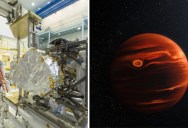The Webb Telescope Is So Powerful It Can Spot Storms In Different Solar Systems

Space is absolutely infinite. We all realize this, but most of the time, there’s no way to truly wrap our minds around what that means.
Thanks to the Webb telescope, though, we can literally see dust storms kicking up in solar systems other than our own – and that puts things into perspective.

Image Credit: NASA
According to this press release, the JWST-detected storm took place on exoplanet VHS 1256. The planet is a “massive brown dwarf” and is located around 40 light years from Earth.
“Ever had hot sand whip across your face? That’s a soothing experience compared to the volatile conditions discovered high in the atmosphere of planet VHS 1256 b.”
The telescope got a good enough look at the distant dust storm to determine the planet’s atmosphere is made of “silicate particles, ranging from fine specks to small grains.”
And that’s not all.
“The team projects that the silicates swirling in these clouds periodically get too heavy and rain into the depths of the planet’s atmosphere. Webb’s observations also show clear signatures of water, methane and carbon monoxide, and provide evidence for carbon dioxide.”
The BBC reports that this planet was first discovered in 2015 by the Vista telescope in Chile. It’s described as a “super Jupiter,” with a similar atmosphere but around 12 to 18 times the mass of our own gas giant.

Image Credit: Webb Telescope
Still, scientists say what the Webb telescope saw is special.
“No other telescope has identified so many features at once for a single target. We’re seeing a lot of molecules in a single spectrum from Webb that detail the planet’s dynamic cloud and weather systems.”
The universe keep expanding, and thanks to telescopes like this one, so does our understanding of it.
I hope it never stops.

Sign up to get our BEST stories of the week straight to your inbox.




